
- Issue 3 Pages 3_049-
- Issue 2 Pages 2_029-
- Issue 1 Pages 1_001-
- |<
- <
- 1
- >
- >|
-
Kinyo On, Yasuko Kato, Masanobu Itoh2023 Volume 92 Issue 1 Pages 1_001-1_015
Published: 2023
Released on J-STAGE: April 29, 2023
JOURNAL FREE ACCESSThe telomere is an indispensable chromatin structure for replication and protection of chromosome ends in eukaryotes. When DNA double-strand-breaks (DSBs) occur, the telomere capping proteins, TRF1 and TRF2, are phosphorylated prior to repair in human cells. Whether a similar phosphorylation of telomere capping proteins occurs in other organisms is not known. To investigate the DSB response of capping proteins in non-human organisms, we used the fruit fly Drosophila, one of the organisms that lacks standard telomeres and telomerase. Our results showed that a Drosophila telomere capping protein, HOAP, was phosphorylated at amino acid (aa) residues 211-270 in response to etoposide. Two DSB repair proteins, Nbs and ATM, were shown to be involved in the phosphorylation of HOAP. These results suggest that HOAP plays a functionally analogous role to mammalian TRF1 and/or TRF2 in the DSB response in Drosophila.
View full abstractDownload PDF (2958K)
-
Prashanth Javanegowda, Likhith Gowda Mahadevegowda, Kunal Ankola, Manj ...2023 Volume 92 Issue 1 Pages 1_017-1_027
Published: 2023
Released on J-STAGE: October 03, 2023
JOURNAL FREE ACCESSNew bivoltine lines (NBL’s) of the silkworm, Bombyx mori L. evolved employing heat shock technology were subjected for evaluation based on multiple traits evaluation index (E.I.) during winter, summer, and monsoon seasons keeping its parentage CSR2 and CSR27 as check breeds. The cumulative score was used to rank the silkworm breeds, and the value of a specific characteristic in a specific genotype was compared to the ranking. Interestingly, all NBL’s exhibited highest larval survivability and lesser larval duration compared to their parental breeds during all the three seasons of rearing. Notably, among different seasons, the larval weight (5.07 g), cocoon weight (2.18 g), cocoon shell weight (0.49 g), pupal weight (1.70 g), cocoon shell percentage (22.25%) and filament length (1, 054 m) were found to be highest during winter and monsoon seasons compared to summer season in NBL-5 being top on the list. Furthermore, the cocoon shell percentage of NBL-5 was 21.49, 21.91 and 22.25% which is highest as against 21.17, 21.89 and 22.02% in CSR2 during winter, summer and monsoon seasons respectively. Taken together, while NBL-5 has performed excellently with higher multiple trait E.I. value being first in the list in all the three seasons, NBL-9 and NBL-10A were also showed better performance with E.I. values greater than 50 irrespective of the seasons. As a result, we suggest NBL-5, NBL-9 and NBL-10A breeds as better parents while preparing disease free layings of cross breed or single and/or double bivoltine hybrids for commercial exploitation to enhance silk output in both tropical and temperate regions during all the seasons.
View full abstractDownload PDF (1339K)
- |<
- <
- 1
- >
- >|